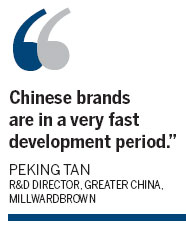Economy
Boost for Chinese fashion brands
By Li Woke (China Daily)
Updated: 2011-05-23 09:06
 |
Large Medium Small |
Development

"Chinese brands are in a very fast development period," said Peking Tan, R&D director of Greater China with MillwardBrown, a world-leading research agency. "The rising Chinese brands also benefit from their huge domestic market, with which they are familiar."
Since the late 1970s, China's garment industry witnessed rapid development under the country's economic reforms and opening-up policies. Dramatic changes caused by these reforms have touched virtually every aspect of China's economy and society.
In 1992, China initiated efforts to establish a market-oriented economy. These reforms improved the flexibility and responsiveness of the Chinese apparel industry. Over time, the Chinese industry has progressed from being largely volume-driven in the 1960s and 1970s to being export-driven in the 1980s and early 1990s to being more consumer-oriented today.
In 1995, China became the largest apparel industry in the world with more than 3.9 million workers employed in 47,000 factories and companies.
China's sewing industry has long been concentrated in its coastal region, with its relatively convenient transportation and communications, good infrastructure and external economies of scale.
The coastal areas were among the earliest regions in China to implement economic reforms. This resulted in increased competition between Chinese private investors and foreign investors in the apparel industry .
|
||||
Chinese garments are well known in Western countries for their moderate or low prices. However, Western luxury brands remain very much a status symbol in China.
The World Luxury Association forecasts China will become the largest luxury goods market and its sales volume will reach $14.6 billion in the next four or five years.
Research from Bain Capital, one of the world's leading business strategy consultancy firms, showed that in 2010, sales of luxury goods increased substantially year-on-year by 30 percent in China, while sales declined in Japan and the US, the world's top two luxury goods markets.
The report said that compared with the strong growth inside the Chinese market, the huge purchasing power of the Chinese is apparent outside the country.
After decades of effort, a few made-in-China brands now produce high quality clothing for high-fashion consumers. Chinese shoppers not only line up outside Chanel and Louis Vuitton stores, they have also started to show off their purchases at NETIGER and Shanghai Tang.
"The Chinese, who used to be a bit shy about their culture and their economy, all of a sudden they won those medals," Raphael le Masne de Chermont, CEO at Shanghai Tang, was quoted by CNN as saying. "They started to feel proud to be Chinese."
That pride helps to support his company's hopes to conquer markets in the West. Shanghai Tang has opened stores in several world fashion cities including London and New York.
"Chinese brands have been recognized by mass consumers, but they are facing problems in building brand-reliability and trust," said Tan.
Because China is expected to be the world's biggest luxury market soon, Chinese culture and preferences cannot be ignored. More than 100 second-tier cities have populations with more than 1 million people and consumers there have both the buying power of their tier-one peers and an interest in luxury brands, according to a report by PricewaterhouseCoopers.
In the West, Chinese culture, Chinese designs and China elements are increasingly accepted. In addition, more Chinese are seeking out goods that emphasize their culture.
"Chinese luxury companies do possess a great opportunity to win the hearts and minds of Chinese consumers, especially when traditional Chinese elements are smartly produced with modern technology and marketing," said Sandy Chen, research director at TNS, a research firm.
| 分享按鈕 |



